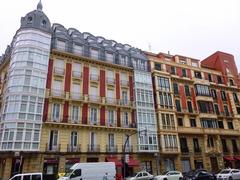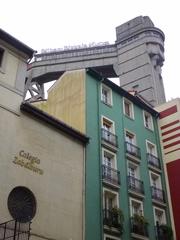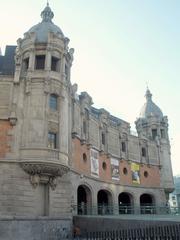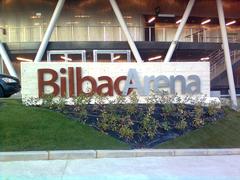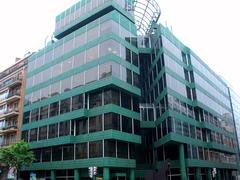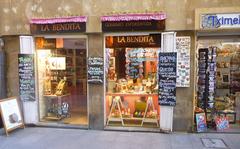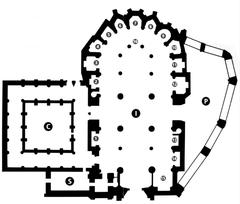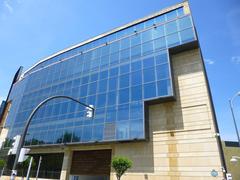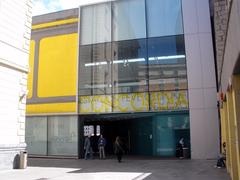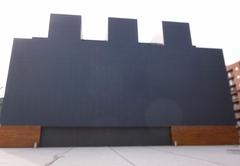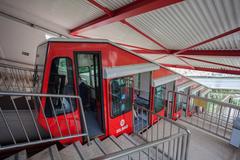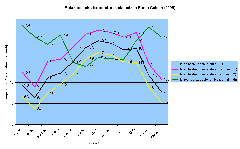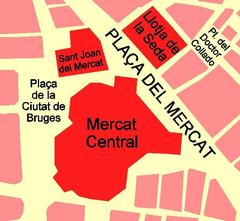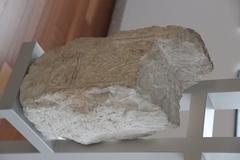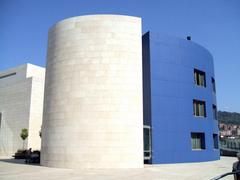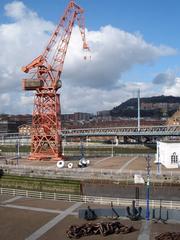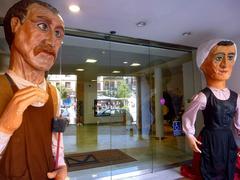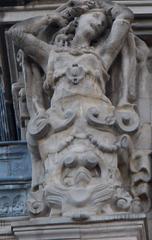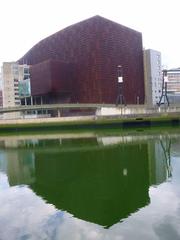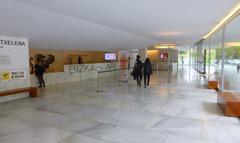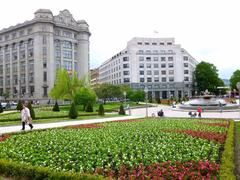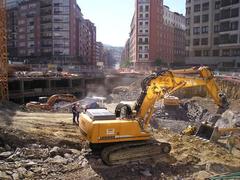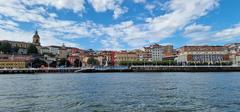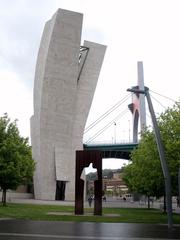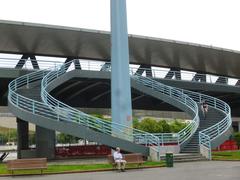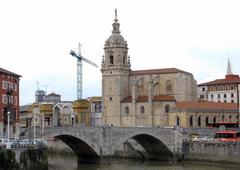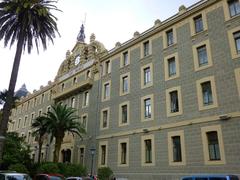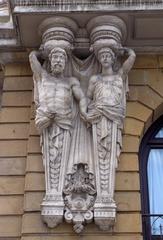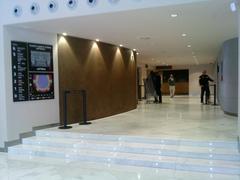
Casa-Torre Urízar Bilbao: Horarios de Visita, Entradas y Guía Histórica
Fecha: 04/07/2025
Introducción
Casa-Torre Urízar, enclavada en el barrio Irala de Bilbao, se erige como la última casa-torre medieval que sobrevive en la ciudad y un vívido testimonio del pasado feudal del País Vasco. Construida entre los siglos XIII y XV por la familia Urízar, esta residencia fortificada refleja la evolución de Bilbao, desde un bastión feudal hasta una ciudad moderna, fusionando arquitectura defensiva con posteriores modificaciones renacentistas y barrocas. Hoy en día, la torre es un sitio cultural protegido, ocasionalmente abierto para visitas guiadas y eventos culturales, y sirve como un vínculo viviente con el rico tapiz histórico de Bilbao (InfoBilbao; Cadena SER; Deia).
Esta guía ofrece una visión general completa de la historia de Casa-Torre Urízar, sus características arquitectónicas, su significado cultural, información práctica para visitantes y consejos de viaje, asegurando que pueda aprovechar al máximo su exploración de uno de los monumentos medievales más evocadores de Bilbao.
Tabla de Contenidos
- Orígenes Históricos y Función Medieval
- Evolución Arquitectónica: del Renacimiento a la Actualidad
- Conservación, Uso Comunitario y Protección
- Visitar Casa-Torre Urízar: Horarios, Entradas, Accesibilidad
- Consejos de Viaje y Atracciones Cercanas
- Significado Cultural e Histórico
- Preguntas Frecuentes (FAQ)
- Conclusión y Recomendaciones para Visitantes
- Fuentes y Lecturas Adicionales
Orígenes Históricos y Función Medieval
Casa-Torre Urízar, construida por la noble familia Urízar, es un ejemplo clásico de la tradición vasca de “casa-torre” —residencias fortificadas erigidas en Vizcaya entre los siglos XIII y XV. Estas torres simbolizaban el prestigio familiar y proporcionaban defensa en medio de las caóticas “guerras banderizas” (guerras de facciones nobles). La estructura original exhibía gruesos muros de piedra, estrechas saeteras y una planta rectangular, todo diseñado para la seguridad y durabilidad (InfoBilbao). Estratégicamente ubicada en lo que entonces era un entorno rural, la torre controlaba importantes rutas y protegía las tierras agrícolas.
Evolución Arquitectónica: del Renacimiento a la Actualidad
Transformaciones Renacentistas y Barrocas
A medida que la estabilidad regional mejoraba en los siglos XVI y XVII, el carácter defensivo de Casa-Torre Urízar se suavizó. La familia Urízar modernizó la torre, introduciendo ventanas más grandes, interiores más refinados y espacios de vida ampliados que reflejaban los gustos y los cambios en el estilo de vida de la nobleza vasca (InfoBilbao). Para el siglo XVII, la torre funcionaba más como una casona rural o “caserío”, integrando usos residenciales y agrícolas.
Siglos XIX y XX: Urbanización, Declive y Restauración
Con la rápida industrialización de Bilbao en el siglo XIX, Irala se transformó de zona rural a urbana, y muchas torres históricas desaparecieron. Casa-Torre Urízar, sin embargo, sobrevivió, aunque no sin la pérdida de algunas características originales. En el siglo XX, la creciente apreciación por el patrimonio llevó a esfuerzos de restauración, estabilizando la estructura y resaltando su legado arquitectónico (Eusko Guide; Deia). Una importante restauración en 2009–2010 no solo conservó el edificio, sino que también descubrió un tesoro de monedas que datan de 1869 a 1937, añadiendo a su mística.
Hoy, Casa-Torre Urízar ostenta el máximo nivel de protección patrimonial de la ciudad —“Protección Especial, Nivel A”— y sirve como sede de la asociación local de jubilados.
Conservación, Uso Comunitario y Protección
La historia estratificada de Casa-Torre Urízar es visible en su arquitectura: elementos defensivos medievales en la base, características renacentistas y barrocas en la parte superior, y adaptaciones modernas para el uso comunitario. Los esfuerzos de conservación han respetado su autenticidad histórica garantizando al mismo tiempo su integración dentro del distrito de Irala en evolución (Archivo Municipal de Bilbao). Su supervivencia en medio de la expansión urbana es excepcional en Bilbao, donde la mayoría de tales torres han desaparecido.
Visitar Casa-Torre Urízar: Horarios, Entradas, Accesibilidad
- Horarios de Visita: El interior de la torre no está abierto al público de forma regular. Es accesible externamente a todas horas, y la fachada puede admirarse a diario desde la calle. Ocasionalmente, se organizan visitas guiadas y eventos culturales —típicamente entre semana, de 10:00 a 14:00, previa cita o durante las jornadas de patrimonio (Bilbao Turismo).
- Entradas: Ver el exterior es gratuito. Las visitas guiadas o la entrada a eventos pueden requerir registro previo; consulte con las oficinas de turismo locales para obtener más detalles.
- Accesibilidad: El área circundante es accesible para sillas de ruedas. Debido al diseño medieval original, el interior (cuando es accesible) incluye escaleras estrechas y suelos irregulares, lo que limita la accesibilidad completa.
- Visitas Guiadas: Ocasionalmente disponibles y muy recomendables para el contexto histórico. Póngase en contacto con las oficinas de Turismo de Bilbao para conocer los horarios.
Consejos de Viaje y Atracciones Cercanas
- Cómo Llegar: Ubicada en el barrio de Irala, Casa-Torre Urízar es accesible en metro (estación Santutxu), líneas de autobús y a pie desde el Casco Viejo.
- Fotografía: La llamativa fachada de piedra de la torre y su yuxtaposición con edificios modernos la convierten en un tema fotográfico cautivador. La luz de la mañana temprano o de la tarde es ideal.
- Atracciones Cercanas: Combine su visita con el Casco Viejo, la Catedral de Santiago, la Plaza Nueva, el Museo Guggenheim y el Museo de Bellas Artes de Bilbao. Los barrios de Santutxu y Basarrate ofrecen un ambiente vasco auténtico y gastronomía local (Full Suitcase).
Significado Cultural e Histórico
Casa-Torre Urízar no es solo una reliquia arquitectónica, sino también un símbolo de la resiliencia y la comunidad vascas. Refleja la transformación de Bilbao de una sociedad feudal medieval a un próspero centro urbano, y su continua adaptación como centro comunitario demuestra la gestión exitosa del patrimonio (Cadena SER; Deia). Leyendas locales y descubrimientos —como el tesoro de monedas oculto— aumentan su encanto, convirtiéndola en un punto focal tanto para la investigación histórica como para la identidad del barrio.
Preguntas Frecuentes (FAQ)
P: ¿Cuáles son los horarios de visita de Casa-Torre Urízar? R: El exterior se puede ver en cualquier momento. Las visitas al interior están limitadas a visitas guiadas especiales, normalmente entre semana previa cita.
P: ¿Hay tarifa de entrada? R: No hay tarifa para ver el exterior. Las visitas guiadas pueden requerir registro previo.
P: ¿Es el sitio accesible para sillas de ruedas? R: El exterior es accesible; el interior puede tener accesibilidad limitada debido al diseño histórico.
P: ¿Hay visitas guiadas disponibles? R: Sí, ocasionalmente. Consulte con las oficinas de Turismo de Bilbao para conocer los horarios actualizados.
P: ¿Puedo tomar fotos? R: Sí, se permiten fotografías en el exterior. Pueden aplicarse algunas restricciones durante los eventos.
P: ¿Qué más puedo ver cerca? R: Casco Viejo, Museo Guggenheim, Museo de Bellas Artes, mercados históricos y parques locales.
Conclusión y Recomendaciones para Visitantes
Casa-Torre Urízar es una parada esencial para cualquiera interesado en la historia medieval de Bilbao, la arquitectura vasca o la evolución de la identidad urbana. Su supervivencia como la última casa-torre medieval de la ciudad, junto con sus características arquitectónicas estratificadas y su uso comunitario continuo, la convierten en un sitio patrimonial cautivador. Se alienta a los visitantes a explorar la torre como parte de un itinerario más amplio de las atracciones históricas y culturales de Bilbao y a consultar los recursos turísticos oficiales para conocer los horarios de visita, tours y eventos actuales (Bilbao Ekintza).
Planifique su visita hoy mismo: descargue la aplicación Audiala para obtener guías personalizadas, actualizaciones en tiempo real y tours exclusivos de los sitios patrimoniales de Bilbao. Apoye los esfuerzos de conservación locales respetando las directrices del sitio y participando en experiencias guiadas.
Fuentes y Lecturas Adicionales
- InfoBilbao
- Deia
- Bilbao Turismo
- Cadena SER
- Eusko Guide
- Documentación Patrimonial del Ayuntamiento de Bilbao
- Full Suitcase
- Bilbao Ekintza
Audiala2024{‘date’: ‘04/07/2025’, ‘task’: {‘model’: ‘gpt-4.1-mini’, ‘query’: ‘Comprehensive guide to visiting Casa-Torre Urízar, Bilbao, Spain: history, significance, visitor tips, and everything tourists need to know for a memorable experience.’, ‘verbose’: False, ‘guidelines’: [“Keyword Research: Identify relevant keywords that potential visitors are likely to search for, such as ‘[Monument Name] visiting hours,’ ‘[Monument Name] tickets,’ and ‘[City] historical sites.’ Use these keywords strategically throughout the article, including in the title, headers, and body text, but avoid keyword stuffing.”, ‘Engaging and Informative Title: Craft a title that is both SEO-friendly and compelling to encourage clicks. Include the main keyword and make it clear what the article will cover.’, ‘Structured Content: Use headings (H1, H2, H3) to organize the content effectively. This helps with SEO and makes the article easier for readers to navigate. Include an introduction that hooks the reader, a detailed body that covers all relevant aspects, and a conclusion that summarizes the key points.’, ‘Comprehensive Coverage: Address common questions and topics of interest such as the history of the monument, its cultural significance, visitor information (e.g., ticket prices, opening hours), travel tips, nearby attractions, and accessibility. Include sections that might be unique to the monument, like special events, guided tours, and photographic spots.’, ‘Quality Content: Ensure the content is well-researched, accurate, and provides real value to readers. Use reliable sources and provide factual information. Write in a clear, engaging, and accessible style. Consider your audience and use language that is appropriate for those likely to visit the monument.’, ‘Visuals and Media: Incorporate high-quality images or videos of the monument. These should be optimized for the web (correct sizing, alt tags with keywords). Consider interactive elements like virtual tours or maps.’, ‘Internal and External Links: Include links to other related articles on your site to encourage deeper engagement (internal links). Link to official websites for the monument or credible sources for further reading (external links).’, ‘FAQ: Incorporate FAQ sections to target voice search queries and featured snippets’, ‘Visit and Stay Up to Date: End the article with a call to action, such as encouraging readers to download our mobile app Audiala, check out other related posts, or follow on social media for more updates.’], ‘max_sections’: 4, ‘publish_formats’: {‘pdf’: False, ‘docx’: False, ‘markdown’: True}, ‘follow_guidelines’: True}, ‘title’: ‘Casa-Torre Urízar, Bilbao: A Comprehensive Visitor’s Guide’, ‘report’: ’# Casa-Torre Urízar Bilbao: Visiting Hours, Tickets, and Historical Guide\n\n#### Date: 04/07/2025\n\n---\n\n## Introduction\n\nCasa-Torre Urízar, nestled in Bilbao’s Irala neighborhood, stands as the city’s last surviving medieval tower house and a vivid testament to the Basque Country’s feudal past. Built between the 13th and 15th centuries by the Urízar family, this fortified residence reflects Bilbao’s evolution from a feudal stronghold to a modern city, blending defensive architecture with later Renaissance and Baroque modifications. Today, the tower is a protected heritage site, occasionally open for guided tours and cultural events, and serves as a living link to Bilbao’s rich historical tapestry (InfoBilbao; Cadena SER; Deia).\n\nThis guide provides a comprehensive overview of Casa-Torre Urízar’s history, architectural features, cultural significance, practical visiting information, and travel tips, ensuring you can make the most of your exploration of one of Bilbao’s most evocative medieval landmarks.\n\n---\n\n## Table of Contents\n\n- Historical Origins and Medieval Function\n- Architectural Evolution: Renaissance to Modern Day\n- Preservation, Community Use, and Conservation\n- Visiting Casa-Torre Urízar: Hours, Tickets, Accessibility\n- Travel Tips and Nearby Attractions\n- Cultural and Historical Significance\n- Frequently Asked Questions (FAQ)\n- Conclusion and Visitor Recommendations\n- Sources and Further Reading\n\n---\n\n## Historical Origins and Medieval Function\n\nCasa-Torre Urízar, built by the noble Urízar family, is a classic example of the Basque “casa-torre” tradition—fortified residences erected across Biscay between the 13th and 15th centuries. These towers symbolized family prestige and provided defense amid the chaotic “guerras banderizas” (noble factional wars). The original structure boasted thick stone walls, narrow arrow slits (saeteras), and a rectangular plan, all designed for security and durability (InfoBilbao). Strategically located in what was then a rural setting, the tower controlled important routes and protected agricultural lands.\n\n---\n\n## Architectural Evolution: Renaissance to Modern Day\n\n### Renaissance and Baroque Transformations\n\nAs regional stability improved in the 16th and 17th centuries, the defensive character of Casa-Torre Urízar was softened. The Urízar family modernized the tower, introducing larger windows, more refined interiors, and expanded living spaces that reflected the tastes and lifestyle changes of the Basque nobility (InfoBilbao). By the 17th century, the tower functioned more as a rural manor or “caserío,” integrating both residential and agricultural uses.\n\n### 19th and 20th Century: Urbanization, Decline, and Restoration\n\nWith Bilbao’s rapid industrialization in the 19th century, Irala transformed from countryside to city, and many historic towers were lost. Casa-Torre Urízar, however, survived—though not without the loss of some original features. In the 20th century, increased appreciation for heritage led to restoration efforts, stabilizing the structure and highlighting its architectural legacy (Eusko Guide; Deia). A significant restoration in 2009–2010 not only preserved the building but also uncovered a hoard of coins dating from 1869 to 1937, adding to its mystique.\n\nToday, Casa-Torre Urízar holds the city’s highest heritage protection status—“Protección Especial, Nivel A”—and serves as the local retirees’ association headquarters.\n\n---\n\n## Preservation, Community Use, and Conservation\n\nCasa-Torre Urízar’s layered history is visible in its architecture: medieval defensive elements at the base, Renaissance and Baroque features above, and modern adaptations for community use. Conservation efforts have respected its historical authenticity while ensuring its integration within the evolving Irala district (Bilbao Municipal Archive). Its survival amid urban expansion is exceptional in Bilbao, where most such towers have vanished.\n\n---\n\n## Visiting Casa-Torre Urízar: Hours, Tickets, Accessibility\n\n- Visiting Hours: The tower’s interior is not regularly open to the public. It is accessible externally at all hours, and the façade can be admired daily from the street. Occasionally, guided tours and cultural events are arranged—typically on weekdays, from 10:00 AM to 2:00 PM, by appointment or during heritage days (Bilbao Turismo).\n- Tickets: Viewing the exterior is free. Guided tours or event entry may require advance registration; check with local tourism offices for details.\n- Accessibility: The surrounding area is wheelchair accessible. Due to the original medieval design, the interior (when accessible) includes narrow stairs and uneven floors, limiting full accessibility.\n- Guided Tours: Occasionally available and highly recommended for historical context. Contact the Bilbao Tourism offices for schedules.\n\n---\n\n## Travel Tips and Nearby Attractions\n\n- How to Get There: Located in the Irala neighborhood, Casa-Torre Urízar is accessible by Bilbao’s metro (Santutxu station), bus lines, and on foot from Casco Viejo.\n- Photography: The tower’s striking stone façade and juxtaposition with modern buildings make it a compelling photographic subject. Early morning or late afternoon light is ideal.\n- Nearby Attractions: Combine your visit with the Casco Viejo (Old Town), the Santiago Cathedral, Plaza Nueva, the Guggenheim Museum, and the Bilbao Fine Arts Museum. The Santutxu and Basarrate neighborhoods offer authentic Basque ambiance and local dining (Full Suitcase).\n\n---\n\n## Cultural and Historical Significance\n\nCasa-Torre Urízar is not only an architectural relic but also a symbol of Basque resilience and community. It reflects Bilbao’s transformation from a medieval feudal society to a thriving urban center, and its continuous adaptation as a community hub demonstrates successful heritage stewardship (Cadena SER; Deia). Local legends and discoveries—like the hidden coin hoard—add to its allure, making it a focal point for both historical inquiry and neighborhood identity.\n\n---\n\n## Frequently Asked Questions (FAQ)\n\nQ: What are the Casa-Torre Urízar visiting hours? \nA: The exterior is viewable at any time. Interior visits are limited to special guided tours, typically on weekdays by appointment.\n\nQ: Is there an entrance fee? \nA: No fee for exterior viewing. Guided tours may require prior registration.\n\nQ: Is the site wheelchair accessible? \nA: The exterior is accessible; the interior may have limited accessibility due to historic design.\n\nQ: Are guided tours available? \nA: Yes, occasionally. Check with Bilbao Tourism offices for up-to-date schedules.\n\nQ: Can I take photos? \nA: Yes, photography is permitted outside. Some restrictions may apply during events.\n\nQ: What else can I see nearby? \nA: Casco Viejo, Guggenheim Museum, Fine Arts Museum, historic markets, and local parks.\n\n---\n\n## Conclusion and Visitor Recommendations\n\nCasa-Torre Urízar is an essential stop for anyone interested in Bilbao’s medieval history, Basque architecture, or the evolution of urban identity. Its survival as the city’s last medieval tower house, coupled with its layered architectural features and ongoing community use, makes it a compelling heritage site. Visitors are encouraged to explore the tower as part of a broader itinerary of Bilbao’s historical and cultural attractions and to check official tourism resources for current visiting hours, tours, and events (Bilbao Ekintza).\n\nPlan your visit today—download the Audiala app for personalized guides, real-time updates, and exclusive tours of Bilbao’s heritage sites. Support local preservation efforts by following site guidelines and participating in guided experiences.\n\n---\n\n## Sources and Further Reading\n\n- InfoBilbao\n- Deia\n- Bilbao Turismo\n- Cadena SER\n- Eusko Guide\n- Bilbao City Council Heritage Documentation\n- Full Suitcase\n- Bilbao Ekintza\n\n---\n\n

